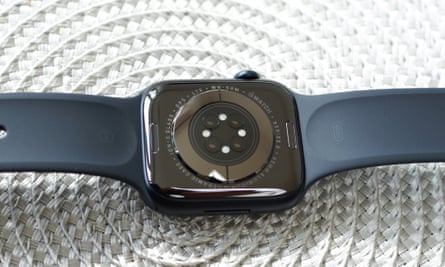
Apple Watch Series 8 review: better women’s health tracking in same capable package | Apple
The latest Apple Watch adds new safety features and a temperature sensor for some intriguing uses for women’s health and family planning. But otherwise it remains the same as last year’s version.
Like the latest iPhones, the Series 8 gets a £50 (A$30 in Australia) price hike over its predecessor, costing from £419 (A$629) despite remaining $399 in the US, owing to weak currency rates against the dollar. But the Series 8 is not Apple’s most expensive new smartwatch. That title goes to the Ultra model costing £849 ($799/A$1,299).
The new, now-midrange Series 8 watch is essentially identical to the Series 7. The iPhone-only smartwatch has a smooth metal body, bright and crisp always-on screen and lasts about 36 hours between charges, including sleep tracking. It is still the most capable of smartwatches.

Adding to the existing fall detection, a new accelerometer and gyroscope can detect the extreme forces associated with a car crash and automatically call the emergency services if you do not respond within 20 seconds. A potentially lifesaving feature that is hopefully just there for peace of mind.
A pair of temperature sensors can track the change in your wrist temperature overnight, setting a baseline over five nights with sleep tracking enabled. It can’t tell you your exact temperature, but small changes can indicate various different things, from exercise and alcohol consumption to sickness and jet lag.

The primary use of the sensor is for optional enhanced tracking of women’s health for logging of menstrual cycle and ovulation. The watch tracks the small increase in body temperature that typically occurs after ovulation, which it combines with logged cycle data to give a retrospective estimate of the day of ovulation. It takes about two cycles for the estimates to be worked out, but it could be a useful tool for those attempting to get pregnant or avoid it, as well as generally tracking their cycle health for irregularities.
Health data collected by the watch, including heart rate, ECG results and cycle data is logged in the Health app on your phone and encrypted end-to-end when backed up to your iCloud account. This means only you and those you intentionally share the data with, such as your partner or doctor, can view it. Neither Apple nor third parties can read it.
Specifications
-
Case size: 41 or 45mm
-
Case thickness: 10.7mm
-
Weight: 32/38.8g or 42.3/51.5g
-
Processor: S8
-
RAM: 1GB
-
Storage: 32GB
-
Operating system: WatchOS 9
-
Water resistance: 50 metres (5ATM)
-
Sensors: HR, ECG, spO2, temp, mic, speaker, NFC, GNSS, compass, altimeter
-
Connectivity: Bluetooth 5, wifi n, NFC, UWB, optional 4G/eSIM
WatchOS 9

The recently released watchOS 9 software added new watch faces, sleep stage tracking and various other small improvements, but one of the best additions was to the workout app.
You can now change the metrics displayed on the face during runs, cycles and other workouts to precisely what you want. There are also new advanced metrics to use, including heart rate zones, running power, vertical oscillation, stride length and ground contact time. You can finally customise interval workouts too. The Series 8 uses about 15{a5ceed037b574a4d8c6b44a0a7290437cee40655417128da3b56d864fe64414f} of the battery tracking an hour-long run, so is capable of covering a marathon.
Sustainability
Apple does not provide an expected lifespan for the battery but it should last in excess of 500 full charge cycles with at least 80{a5ceed037b574a4d8c6b44a0a7290437cee40655417128da3b56d864fe64414f} of its original capacity and can be replaced for £85. Repairs cost between £309 and £409 depending on the model.
It contains recycled aluminium, gold, rare earth elements, tin and tungsten. Apple offers trade-in and free recycling for devices, and breaks down the watch’s environmental impact in its report.
Price
The Series 8 comes in two sizes and two different materials, plus the option of 4G that requires an eSIM and compatible phone plan add-on.
The aluminium or Nike versions in 41mm cost £419 ($399/A$629) or £449 ($429/A$679). 4G models cost an extra £110 ($100/A$160). Stainless steel models cost from £729 ($699/A$1,099).
For comparison, the Apple Watch SE costs £259, the Apple Watch Ultra costs £849, the Samsung Galaxy Watch 5 costs £269 and the Garmin Venu 2 costs £299.
Verdict
The Series 8 is the most minor update to the Apple Watch in a few years. That’s not necessarily a bad thing, since its predecessor was the best smartwatch available for the iPhone and that’s still true for the new model.
Crash detection is a nice feature to have that you hope you’ll never use. While ovulation tracking is not new, there are only a handful of consumer wearable devices, such as certain Fitbits and the Oura Ring, that offer similar features. It is good to see more thorough women’s health tracking being added to another mainstream device. Data from the temperature sensor may also turn out to be useful for other wellness features in the future, too.
If you have a recent model it isn’t worth the upgrade. But if you’re looking for a new general smartwatch for an iPhone, the Apple Watch Series 8 is the one to buy. It is head and shoulders above the competition, it’s just a shame about the currency-caused price hike.
Pros: excellent haptic vibrations, always-on screen, ECG, temp sensor, top health tracking, great activity tracking, 50-metre water resistance, solid battery, car crash detection, long software support, recycled materials.
Cons: expensive, only works with an iPhone, blood oxygen data not that useful, no third-party watch faces, a minor upgrade.






